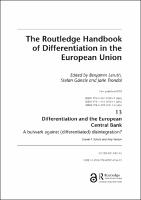Chapter 13 Differentiation and the European Central Bank
Proposal review
A bulwark against (differentiated) disintegration?
Abstract
As the guardian of the euro, the European Central Bank (ECB) oversees a prime example of differentiated integration. Against the backdrop of the multiple crises of the euro’s second decade, this contribution asks how the ECB has dealt with differentiation. It analyses both the historical development of the ECB’s relationship with euro outsiders – discerning between ‘old’ opt-outs and ‘new’ accession countries in the context of EU enlargement – and how differentiation affects ECB policymaking across its various tasks. Specifically, we analyze three logics of ‘deepening’ and ‘widening’: (1) Is the ECB encouraging euro membership among the ‘outs’? (2) Does it seek to reduce the impact of differentiation by keeping the ‘outs’ on board as much as possible? (3) Or does the ECB further cement differentiation by excluding the ‘outs’ from decision-making or deepening integration among the ‘ins’ only? We find that, in the past, the ECB has been hesitant to support ‘more Europe’. When the sovereign debt crisis posed a potentially existential threat, however, the ECB started adopting a more proactive role through both monetary policies and discursive acts. The COVID-19 crisis appears to confirm that the ECB has shed its narrow technocratic focus in order to provide political leadership in the EU. Yet, in our view, this does not suggest that the ECB is a competence maximizer ‘hardwired’ to ever closer union. Rather, the evidence suggests that it merely accepted greater powers and a deepening of integration to avert the threat of (differentiated) disintegration.


 Download
Download